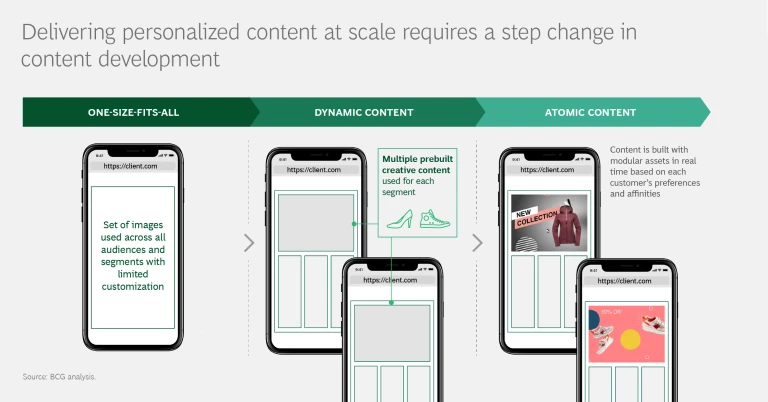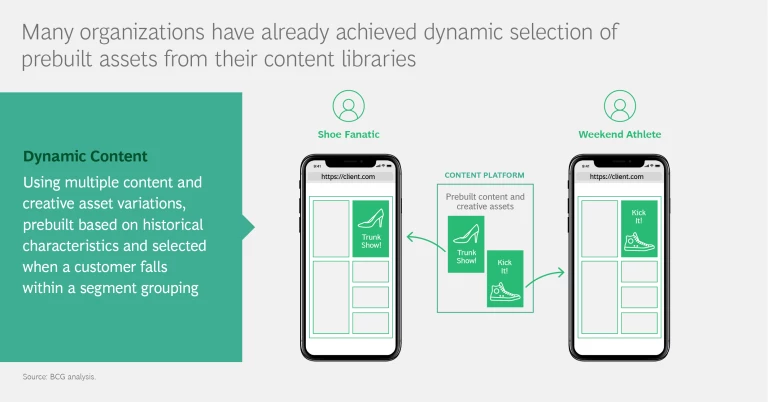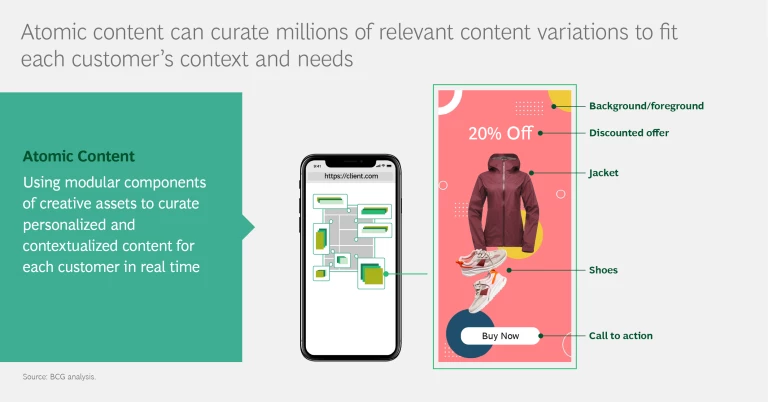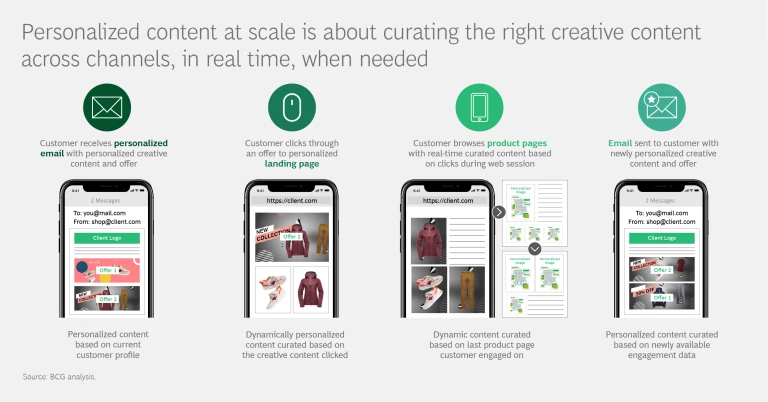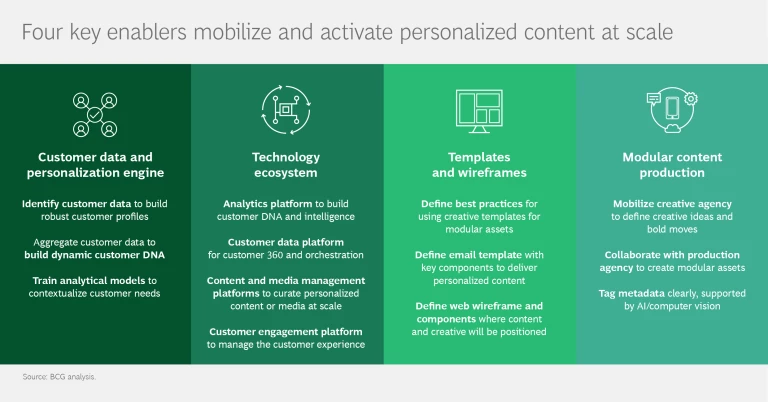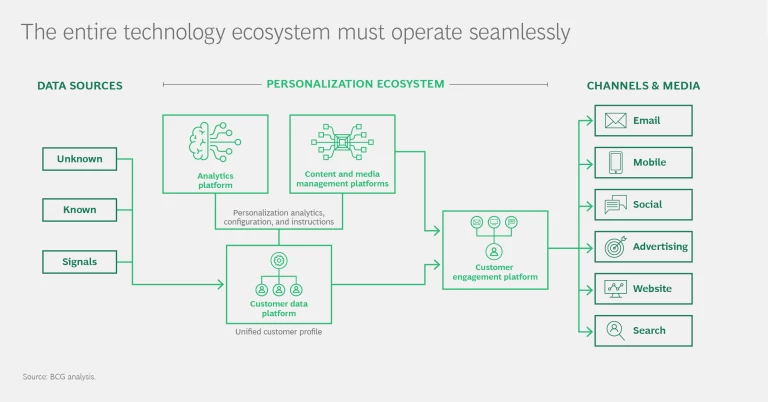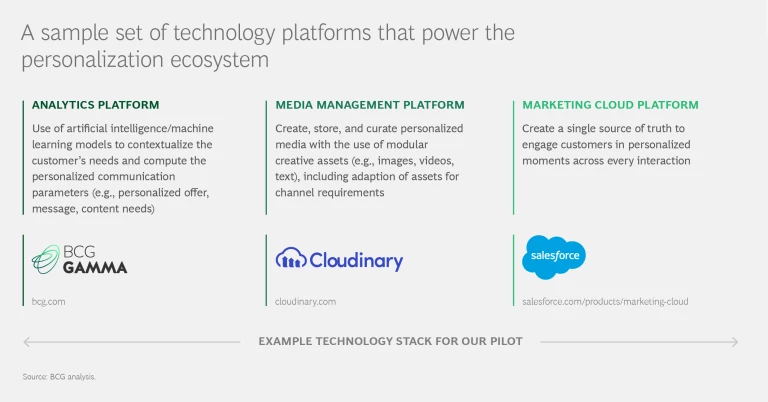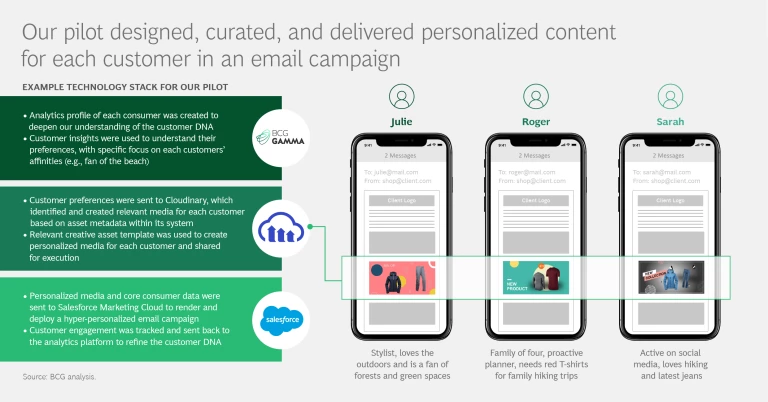The ability of companies to personalize engagement with customers at scale has come a long way in a short time. More companies are showing that interacting with customers on a one-to-one level can drive step changes in growth. Brands that are personalizing where and how they engage consumers are winning a disproportionate share of sales.
But there are ways to do even better. One is to customize the individual’s experience at the point of interaction. Another is the ability to consistently personalize across multiple channels. It works like this: Customer John, while waiting in the restaurant drive-through queue, receives tailored menu suggestions on his phone, based on his order history (he is a member of the restaurant’s loyalty program) and themed to his favorite football team. Customer Jane, who is getting into her car two blocks away, receives an email offer for a cold drink and healthy snack that recognizes her preferences and that she has just left the gym. Until now, however, delivering this level of specificity has been limited by available activation technologies and the ability to select, customize, and adapt relevant content for different interaction points and personal preferences.
This is about to change. By bringing together advanced analytics, new content and media management practices and technology, and a flexible engagement platform, we can unlock the potential of personalized content at the point of interaction. Here’s how.
Climbing the Curve
Companies looking to move to the next generation of personalized campaigns that incorporate not only personalized text but also personalized media assets such as images and videos face three challenges. The first is that the production of such content is still a time-consuming and expensive process. Generating multiple variations of content (for example, deploying different formats, backgrounds, foregrounds , and image variations for different customers) is generally the biggest bottleneck. Second, the retrieval of content that can personalize an interaction typically requires accessing a particular creative asset that is embedded into the source code of a computer program. This must be captured and coded in the analytics engine or uploaded to the marketing tool—a largely manual, and therefore slow and cumbersome, process. Third, adapting content to fit the destination (for example, Facebook has different requirements than a web page both for the HTML and image dimensions) or to produce multiple sets of the same content for different destinations requires purpose-built technology. These technical constraints mean that the content creation process typically focuses on mass communications or only a handful of segments, which limits the ability to truly personalize the content and creative assets for individual customers.
The solution lies in producing content as individual components that can be combined with increasing degrees of sophistication. Moving beyond simple tag replacement (inserting the person’s name at the top of an email, as in “Dear John…” or “Dear Jane…”) requires creating dynamic—and ultimately atomic—content.
Dynamic content—content that is flexible to fit a segment or consumer context—is typically based on personalized scripts (if a customer likes burgers, show an image of a burger; if a customer likes salads, show a salad). For example, we helped a major airline build a dynamic content factory to which it added 20 to 40 new elements every week. By the end of the first year, it had thousands of pieces of content to deploy using artificial intelligence into dynamic templates that combined email, web, and paid channels.
More-sophisticated dynamic assembly leverages AI to select the best combination of modular components and determine how they should be combined according to rules that the marketer sets (for example, past purchases, gender, and interaction context). Personalized content based on atomic components goes one step further—the modular assets are turned into personalized images on the fly by mixing and matching text and existing creative assets, based on an individual’s established likes and preferences. An image is created for John by compiling images of a burger, a golf course, and a milk shake, while Jane gets an image created by combining separate pictures of a salad, a beach, and an iced coffee. Imagine automatically creating this content in real time, at scale, accounting for very specific circumstances and behavior (say John is playing golf and it starts to rain).
To make sure that the creative elements and the data science work together and do not result in “Frankenstein” outcomes, we recommend four guiding principles.
- Template Design. Use data to extract insights on how customers engage with creative assets (What content do they hover over the most? Where do they typically click?) to help define the optimal creative template and how components on the template should look (show a person in the right two quadrants of the screen, for example, and an offer in the upper-left quadrant).
- Test and Learn. Ensure that you continue to use pilots to test your hypotheses on the creative assets that best engage with the consumer, including how to optimize components on a creative template for atomic content and learn from what works and what doesn’t.
- Creative-Specific KPI Framework. Clearly define KPIs with as much specificity as possible to better understand how creative assets perform across channels and campaigns to shape future content creation.
- Analytics-Based Culture. Embed analytics into the creative process so that the creative director and data scientist work together to refine their image analytics by measuring performance, refining templates, and innovating the content curation process with AI methodologies.
Both dynamic and atomic content personalization work best when text, images, and other elements used for personalization are tagged and stored in a library inside a robust content and/or media management platform. Such a platform is an essential part of an omnichannel engagement strategy as it allows the most relevant images or content to be retrieved and constructed based on advanced analytics input and individual customer preferences. Each final personalized content or image is unique, designed to meet the contextualized need of the consumer at the point of interaction and distributed accordingly. This may require different formats to fit different communication channels (again, think of the Facebook versus web page example). An advanced content and/or media management platform should be capable of rendering each content or image format to meet the relevant destination requirements, and the process must be automated to enable scale. Building a creative content library that is 60% to 70% evergreen enables the AI algorithms to learn over time, especially in fast-moving categories such as fashion, where plenty of creative media and/or content is about lifestyle or aspiration, not just the latest new SKUs.
For a graphic description of how this process works, see our slideshow below.
The Opportunities for Companies
To build advanced personalized content capability, companies need to focus on three areas: process, talent, and technology.
Process. Today, organizations typically rely on “head-to-toe'” communications; that is, emails, display ads, or other campaign assets. In the new content paradigm, organizations will produce atomic-level creative components (such as background and foreground images and text) and a machine will use customer data to put together the relevant components and put out tailored content. To do this, companies need great metadata about their creative content elements and a clear process for ongoing data capture and tagging.
This shift mandates a development structure that focuses on the atomic components over the creative whole. Developers need to think about how content connects to themes. For example, how does content about remodeling connect to the different rooms in a house? The dynamic assembly process also requires governance and procedures that enable the final rendered content to be produced automatically. Auditing and measurement processes monitor, manage, and optimize the process based on results.
Talent. The content development team needs to evolve from a primarily creative capability and culture to one that encompasses digital and data skills. While creativity remains key, using data in the design of creative templates (for instance, where is the best place to position offers on an image?) and selecting components based on metadata become essential skills. Fundamentally, the skill set of a creative director changes, and his or her team needs the ability to test and learn, measuring success using digital metrics, and applying this information to optimize the impact of creative assets. The team will be cross-functional and include creative talent, data and analytics experts, data scientists, and software engineers.
Technology. Companies will need flexible and best-in-class open and modular technology, including a multiplatform tech stack. A customer data platform will store and segment data, unify consumer profiles, and activate audiences across channels. An analytics platform will drive the personalization requirements, and a content platform will assemble pieces of content together in different forms and shapes to personalize the creative treatment for each customer. The engagement platform plugs in the content dynamically to personalize the experience at the point of interaction.
The engagement platform must provide an overall orchestration and configuration mechanism that enables the components of the stack to communicate through a flexible and scalable data layer. This entails making outbound messaging aware in real time of ongoing and past customer treatments. Ideally, businesses will be able to optimize both outbound communications and in-the-moment interactions against a common set of goals to ensure consistent treatments along each step in the customer journey.
Getting More Personal
This all adds up to a big change for most organizations. Rather than building out a fully developed capability, we recommend an agile, iterative approach that starts with a few use cases and minimum viable content personalization product (MVP) that can be improved and perfected based on actual experience and market feedback. This high-level roadmap can help you get there.
- Identify a couple of key use cases and set up a cross-functional team to execute. Focusing on only a few use cases to start the journey and executing end-to-end enables learning across the entire process.
- Identify and design some initial campaigns and define the goals of communications, the extent of the personalization you want to achieve, and the creative requirements.
- Set up the data and technology environment, including analytics, the atomic components required to support the intended creative content, the engagement platform, content and/or media management platforms, the templates needed to support the dynamic content generation, and the configuration layer between the various components.
- Execute an MVP campaign with exposure to a small number of customers. Measure the outputs and make the changes dictated by the MVP experience, test, and readjust. It will take a few rounds to start optimizing the process, including the dynamic content generation templates. To make sure that the content output is what you expect, you’ll want to execute multiple tests before starting to scale.
- Add new use cases, campaigns, and channels, developing incremental atomic-level content and performing the required technical integrations. Continue the incremental pilot execution, optimize the dynamic content generation, and create more templates.
- Scale up the dynamic personalization campaigns while reducing static content until you reach the optimum balance (not all campaigns may need to be created through atomic content).
The ability to deliver individually relevant content at scale is the next frontier of marketing. The companies that develop this capability first will be able to use it to cement customer relationships that will be difficult for competitors to break up.


